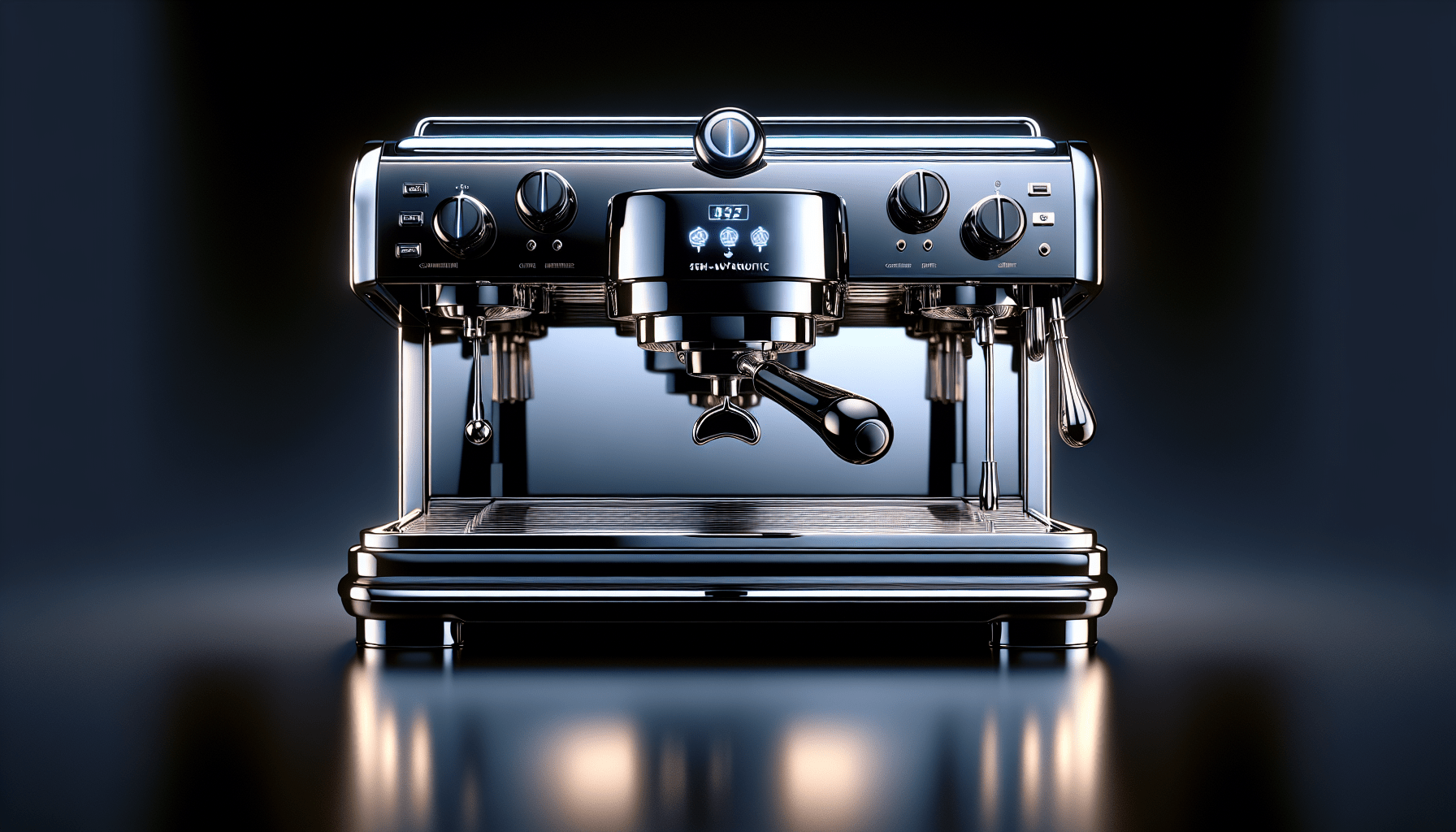Are you a coffee lover who’s always dreamed of turning your kitchen into your very own café? Well, look no further, because we’ve got the ultimate beginner’s guide for you! In this article, we’ll walk you through the ins and outs of frothing milk with a semi-automatic espresso machine. With just a simple flick of a button and a few expert tips, you’ll be able to create rich and creamy foam that will take your homemade lattes to the next level. So grab your favorite mug, and let’s get started on your journey to becoming a barista extraordinaire.
What is frothing milk?
Frothing milk is the process of heating and aerating milk to create a rich and creamy foam, commonly used in cappuccinos, lattes, and other specialty coffee drinks. It adds a velvety texture and enhances the flavor profile of the espresso. Frothing milk can be done using a steam wand, which is a small tube attached to an espresso machine that emits steam.
Definition of frothing milk
Frothing milk refers to the process of incorporating air into the milk, creating tiny bubbles and a frothy texture. This is achieved by using the steam wand on an espresso machine to heat and aerate the milk.
Purpose of frothing milk
The main purpose of frothing milk is to enhance the taste and presentation of espresso-based drinks. Frothed milk adds a layer of creaminess and sweetness to the coffee, balancing the bitterness of the espresso. It also allows for the creation of beautiful latte art, which adds an aesthetic appeal to the beverage.
Preparing the milk
Before frothing milk, it is important to properly prepare the milk for the best results.
Choose the right kind of milk
To achieve the desired texture and taste, it is crucial to choose the right kind of milk. Whole milk is commonly preferred for frothing due to its higher fat content, which contributes to a creamier and thicker foam. However, you can also use skim or low-fat milk if you prefer a lighter consistency.
Select the right temperature
The temperature of the milk plays a significant role in the frothing process. It is generally recommended to start with cold milk, as it allows for better control and manipulation of the foam. However, the ideal temperature for frothing milk is around 140°F (60°C). Using a thermometer can help you achieve consistent results.
Measure the desired quantity
It is important to measure the desired quantity of milk before frothing. This will depend on the size of the drink you are preparing. It is recommended to fill the pitcher to about one-third full to allow space for the expansion of the milk as it froths.
Understanding the steam wand
To froth milk effectively, it is essential to understand the steam wand and its role in the process.
What is a steam wand?
A steam wand is a protruding metal tube attached to an espresso machine that releases steam. It is used for frothing and steaming milk, allowing for the creation of foam and hot milk for various coffee beverages.
Locating the steam wand on your espresso machine
The steam wand is typically located on the side or front of the espresso machine. It usually extends outwards and has a control knob or lever to regulate the steam flow. Refer to the user manual of your specific espresso machine to locate and familiarize yourself with the steam wand.
Cleaning and maintaining the steam wand
To ensure optimal performance and hygiene, it is important to regularly clean and maintain the steam wand. After each use, wipe the steam wand with a clean cloth or towel to remove any milk residue. Periodically, use a designated steam wand cleaner to remove any built-up milk deposits. This will prevent clogging and ensure a consistent flow of steam.
Techniques for frothing milk
To achieve the perfect frothed milk, it is important to master the techniques involved in the process.
Positioning the steam wand
To achieve the best results, position the steam wand just below the surface of the milk, with the tip slightly off-center. This will promote the creation of a whirlpool effect, helping to incorporate air evenly throughout the milk.
Starting the steam
Before starting the steam, make sure to properly purge the steam wand by opening the steam valve for a few seconds. This removes any condensation or water build-up that may affect the frothing process. Once purged, lower the steam wand into the milk, ensuring it is submerged.
Creating microfoam
To create a velvety texture and microfoam, turn on the steam by fully opening the steam valve. Position the steam wand so that it creates a gentle swirling motion within the milk. As the milk expands and froths, gradually raise the pitcher to maintain the proper depth between the milk and the steam wand. Intermittently raise and lower the pitcher to distribute the heat evenly and prevent scorching.
Avoiding large bubbles
To achieve a smooth and creamy foam, it is important to avoid the formation of large bubbles. This can be achieved by maintaining a proper depth between the steam wand and the milk, as well as controlling the steam pressure. Avoid forcefully injecting steam into the milk, as this can result in large bubbles and a less desirable texture.
Techniques for texturing milk
While frothing milk creates a creamy foam, texturing milk involves manipulating the milk to achieve the desired consistency and smoothness.
Technique 1: Stretching
Stretching refers to the process of incorporating air into the milk to create a lighter texture. To stretch the milk, initially position the steam wand closer to the surface of the milk and slowly introduce steam. This will create a gentle hissing sound as the air is pulled into the milk, resulting in a stretchier and lighter foam.
Technique 2: Mixing
Mixing involves swirling the pitcher to evenly distribute the foam throughout the milk. This technique helps homogenize the texture and prevents any separation between the foam and milk. After stretching, gently swirl the pitcher in a circular motion to mix the foam and milk together.
Technique 3: Polishing
Polishing refers to the process of smoothing out the texture of the milk by lightly tapping the pitcher on a flat surface. This helps remove any remaining large bubbles and creates a silky and velvety texture. Tapping the pitcher also helps the foam and milk blend together seamlessly.
Common mistakes to avoid
To achieve the best results when frothing milk, it is important to avoid common mistakes that can affect the texture and taste of the foam.
Heating the milk too much
One common mistake is overheating the milk, which can result in a burnt taste and destroy the delicate texture of the foam. It is crucial to monitor the temperature of the milk closely and stop frothing when it reaches around 140°F (60°C).
Not properly purging the steam wand
Failing to properly purge the steam wand before frothing can result in an inconsistent flow of steam and affect the texture of the milk. Make sure to always purge the steam wand for a few seconds to remove any residual water or condensation.
Improper milk texture
Achieving the desired milk texture is crucial for creating the perfect foam. Over-stretched or under-stretched milk can result in uneven foam and an unsatisfactory taste. Practice and experimentation are key in achieving the ideal texture for your desired coffee beverage.
Troubleshooting
Sometimes, issues may arise during the frothing process. Here are some common troubleshooting tips to address them.
Milk not frothing properly
If the milk is not frothing properly, ensure that you have chosen the right kind of milk and that it is cold. Additionally, check the steam pressure and adjust it accordingly. If all else fails, clean the steam wand thoroughly to remove any potential blockage.
Steam wand not functioning
If the steam wand is not functioning, check if the machine has enough water and if the steam valve is fully open. Additionally, inspect the steam wand for any clogs or blockages. If the issue persists, consult the user manual of your espresso machine or contact a professional technician.
Inconsistent texture
If you are experiencing inconsistencies in the texture of the frothed milk, ensure that you are using consistent techniques and properly maintaining the steam wand. Improper positioning of the steam wand and inconsistent steam pressure can also contribute to inconsistencies. Practice and patience are key in achieving a consistent texture.
Creating latte art
Once you have mastered the art of frothing milk, you can begin exploring the world of latte art. Latte art involves using the frothed milk to create intricate designs on the surface of the coffee. This can be achieved by pouring the frothed milk into the espresso in a specific manner, creating patterns, hearts, or even intricate drawings.
Basics of latte art
To create latte art, start by pouring the frothed milk into the espresso slowly, ensuring a steady and controlled stream. Tilt the cup slightly and pour from a low height to allow the milk to sink gently into the coffee. As you become more comfortable, you can experiment with pouring techniques and patterns to create beautiful designs.
Using frothed milk to create designs
The frothed milk serves as a canvas for your creativity in latte art. By manipulating the flow of milk and controlling the pouring technique, you can create different designs and patterns. Common designs include hearts, rosettas, and tulips, but you can experiment with your own unique creations. Remember to have fun and be patient as latte art mastery takes time and practice.
Cleaning up
After frothing milk, it is important to properly clean the equipment to maintain hygiene and ensure the longevity of your espresso machine.
Properly cleaning the steam wand
After each use, it is crucial to clean the steam wand to prevent any milk residues from drying and clogging it. Using a clean cloth or towel, remove any milk residue from the steam wand by wiping it thoroughly. For a more thorough cleaning, use a designated steam wand cleaner according to the manufacturer’s instructions.
Removing milk residues from the pitcher
To prevent bacterial growth and maintain the cleanliness of your milk pitcher, wash it immediately after each use. Use warm, soapy water and a sponge or brush to remove any milk residues. Rinse the pitcher thoroughly to ensure there is no soap residue left behind. Allow the pitcher to air dry or use a clean towel to dry it completely.
Practice makes perfect
Frothing milk is a skill that requires practice and patience to master. As you familiarize yourself with the techniques and equipment, continue to experiment and refine your frothing skills. By varying the milk type, temperature, and techniques, you can discover your preferred texture and taste. Embrace the learning process and enjoy the journey towards becoming an expert in frothing milk with a semi-automatic espresso machine.



